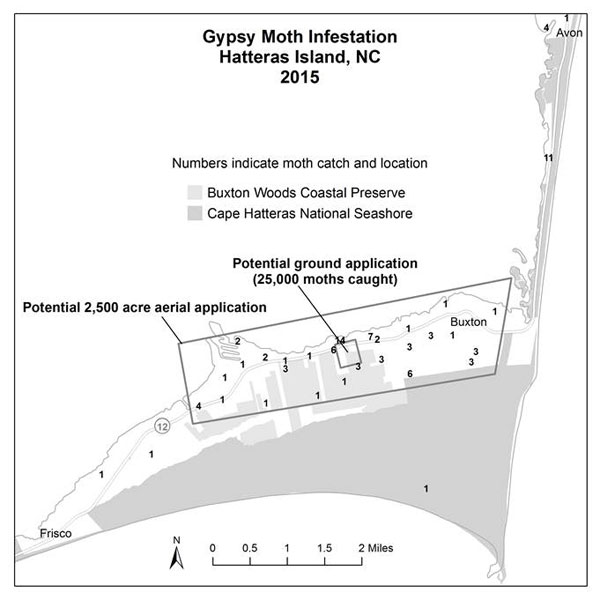State agency sets meeting on ‘severe’ gypsy moth infestation in Buxton Woods

The North Carolina Department of Agriculture and Consumer Services’ Plant Industry Division has scheduled a public meeting for Tuesday, Sept. 22, at 7 p.m. in the Fessenden Center on Highway 12 in Buxton.
At the meeting, division officials will present a plan to eradicate a severe, isolated infestation of the invasive gypsy moth in the Buxton Woods State Reserve area of Buxton and Frisco — an infestation that threatens the maritime forest’s live oak trees with defoliation and eventually death.
“The infestation is intense, but small and very treatable,” says Chris Elder, gypsy moth program manager in the Plant Industry Division.
Elder says the gypsy moth, Lymantria dispar, is an invasive forest pest from Europe and Asia that was first introduced in the U.S. in Massachusetts in 1869. Since then, the moths have been slowly spreading south and west and can be spread via vehicles, trailers, and other outdoor articles.
To the north, much of coastal Virginia is quarantined because of gypsy moth infestations, and the entire state of North Carolina has been surveyed for gypsy moths since 1982. Since then, more than 100 intervention programs have been initiated to either eradicate isolated populations or suppress populations close to the leading edge of the gypsy moth’s advancing front.
One county, Currituck, and a portion of a second county, Dare — generally from Kill Devil Hills north — are currently quarantined for gypsy moths.
This spring, the gypsy moth turned up on Hatteras Island when a property owner notified the NCDA-CS that various stages of the pest has been identified by a pest control company on several live oak trees that had been defoliated on his property near Old Doctor’s Road in Buxton Woods.
Elder says the division confirmed the presence of the gypsy moths and hung numerous green and orange traps on trees and shrubs throughout the island this summer — especially in the Buxton Woods. The traps are designed to capture male moths.
“Unfortunately,” the division said in a letter to landowners earlier this month, “extremely high male moth catches and the identification of other gypsy moth life stages this summer indicate that a reproducing population is established near Buxton Woods.”
Gypsy moths feed particularly on live oaks on Hatteras Island, and Elder says heavy defoliation was observed on many of the live oaks along Highway 12 in Buxton this spring.
Most of the damage is done by the larval stage of the gypsy moth, which is a caterpillar. When the caterpillars hatch in the spring, they spread out and feed on the leaves. The caterpillars then morph into cocoons, from which the adult moths eventually emerge.
The female gypsy moth, which is flightless, can lay an egg mass composed of between 300 and 1,000 viable eggs, which hatch in the spring and start the life cycle again.
Repeated defoliation by the caterpillars can kill live oaks, which would be devastating to the ecology of the maritime forest. As the division official notes in its letter, it “would result in the radical alteration of this sensitive natural habitat.”
At the meeting on Sept. 22, division officials will be soliciting public input on various alternatives for treating the gypsy moth invasion. They will also be talking to landowners about how they can help fight the moth, which includes learning to identify various life stages of the moth.
Elder said the Plant Industry division will also be seeking input from other agencies, such as the Forest Service and the National Park Service, which owns land in the Buxton Woods.
Various effective treatments for gypsy moth infestations are available, Elder said, and will be discussed at the meeting.
He talked about one such treatment, which is preferred in this case and is known as btk.
According to the division’s website, Btk — Bacillus thuringiensis var. kurstaki — is a bacterium commonly found in forest soils worldwide. It has become one of the most valuable biological pest management tools for a variety of agricultural, forestry, and urban pests. While it is highly toxic to target pests, it is very safe in regard to humans and animals and gardens. For example, different formulations of the same biopesticide are labeled to be applied to organic grains such as shelled corn and soybeans during storage and/or to organic bagged grains (popcorn) to prevent Indian meal moth.
Elder said that Btk is applied by aerial spraying, which is done in the spring after the caterpillars hatch. It is usually applied twice, five to 10 days apart. Ground applications are also used in the most heavily infested areas.
The information sent to homeowners with the meeting announcement includes a map with a potential area for application that totals about 2,500 acres and includes most of Buxton and parts of Frisco.
If the Plant Industry Division proceeds with treatment, Elder said there would be a follow-up meeting in the winter and that the division will prepare an environmental assessment.
For more information on gypsy moths, go to the website of the Plant Industry Division, http://www.ncagr.gov/plantindustry/Plant/entomology/GM.htm.
CLICK HERE TO VIEW SLIDE SHOW












